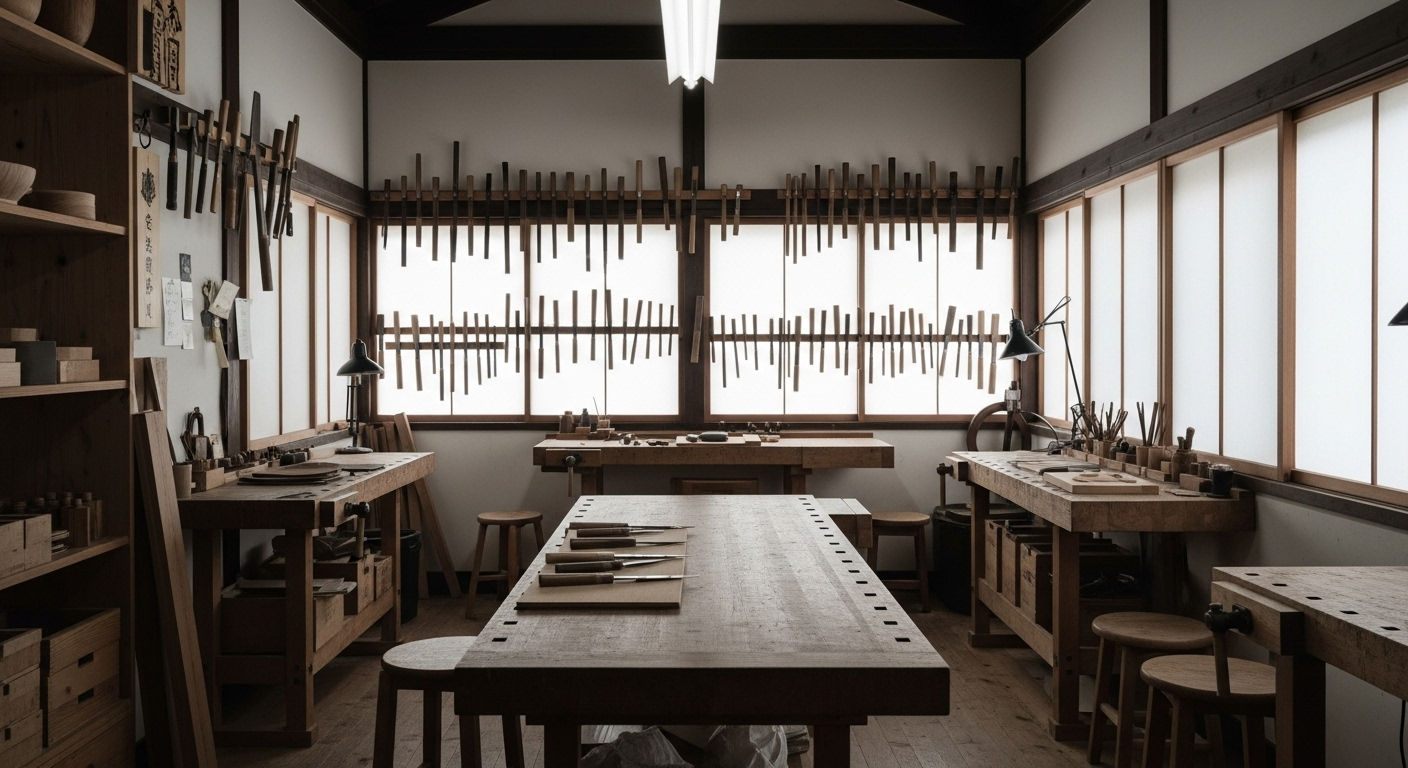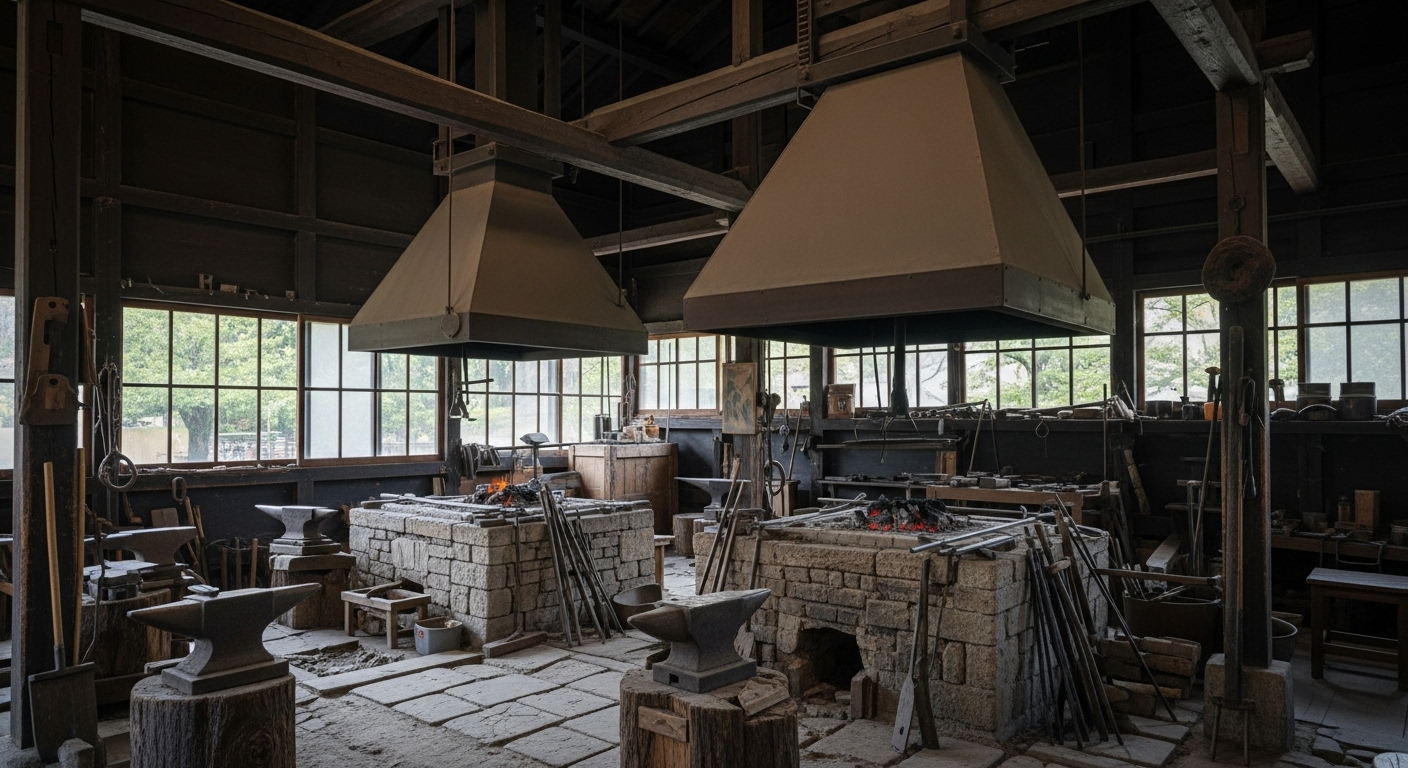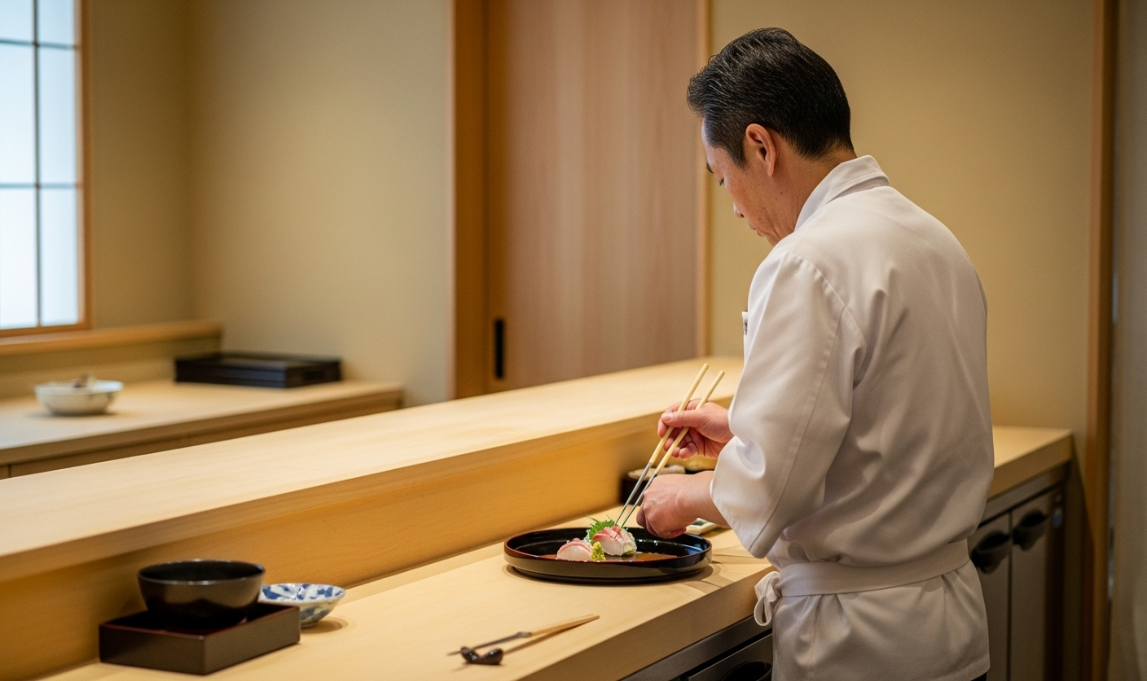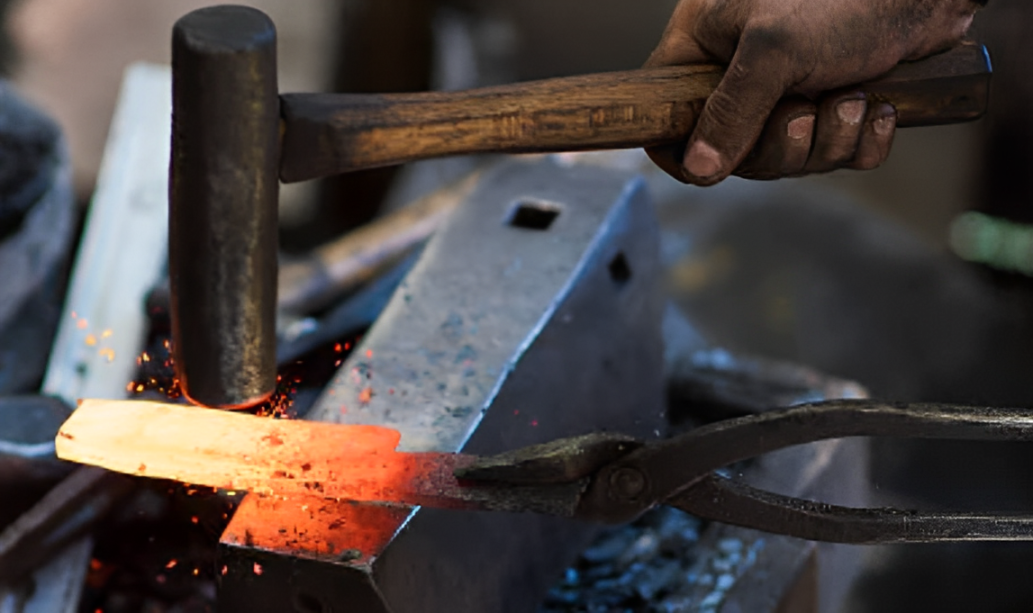
Part of a Japanese Knife
-
Japanese Knife Structure — Why Every Detail Matters
Every Japanese knife is more than steel and edge—it is a composition of details, each with purpose, history, and meaning.
From the razor-thin Hasaki to the guiding line of the Shinogi, and the hidden hollow of the Urasuki, these features are the true language of Japanese blades.This video will reveal how these parts work together to create the balance, sharpness, and elegance that chefs around the world admire.
-
The Meaning Behind the Blade — Understanding the Form and Function of Japanese Knives
-
A Japanese knife is not just a cutting tool. It embodies generations of craftsmanship and skill. From the curve of the spine to the angle of the blade, every detail is carefully designed to enhance sharpness, balance, and control.
-
This guide breaks down the structure of a traditional Japanese knife part by part. It goes beyond just naming the parts to explain how each influences real-world use—for example, the shape of the tip for delicate slicing and how the bevel affects cutting feel.
-
We’ve also included the original Japanese terms (kanji and romaji) for each part. Knowing these will deepen your understanding and appreciation when watching Japanese sharpening videos or craftspeople at work.
-
Whether you’re new to Japanese knives or a seasoned user, this guide will help you see the knife as a refined, purpose-built instrument, not just a tool.
1. The Functional Beauty of a Japanese Knife — Names and Roles of Each Front-Side Part
-
From the tip to the handle, the front side of a Japanese knife is precisely engineered for smooth movement and seamless control. Each shape has a clear purpose, contributing to the knife’s sharpness and feel.
In this section, we introduce the main parts on the front side of a Japanese knife—explaining their names, locations, and specific roles.
We also include the Japanese names (kanji + romaji) to help you follow tutorials and better connect with the craftsmanship.
-

Use the diagram below to see where each part sits and how they come together in the overall design.
-

①Kissaki (Tip)
1. Main Uses
The tip, or Kissaki, is located at the very front end of the blade. It is the part that often first touches the ingredient, especially when filleting fish or making precise, delicate cuts.2. Key Role
Because of its delicate shape and need for sharpness, a properly functioning tip allows for fine and accurate work. As the “starting point” of the blade edge, the tip greatly influences the knife’s overall cutting performance and handling.3. Care Tips
The tip has a unique angle that differs from other parts of the blade, making it difficult to achieve sufficient sharpness with standard sharpening methods. It requires sharpening at a slightly different angle, and even small deviations can significantly affect cutting ability and control. Sharpening at the wrong angle may cause the tip’s shape to deform, negatively impacting not only appearance and balance but also usability and safety. -

②Hasaki (Edge)
1. Main Uses
The edge, located from the shinogi (ridge) to the ago (heel) of the blade, is the part where force is most effectively applied during cutting. Typically, the blade is inserted into the ingredient starting at the edge, and pressure is applied while pushing the blade forward.2. Key Role
The edge efficiently transmits cutting force and allows for smooth separation of the ingredient. Working in conjunction with the shinogi and hira (flat), it plays an important role in both pushing and slicing motions.3. Care Tips
Because the edge frequently contacts ingredients, it is prone to chipping and wear. To maintain sharpness, regular and careful resharpening is necessary. When sharpening, it is important to keep the angle consistent to avoid distorting the shape of the edge. -

③Hamoto (Heel)
1. Main Uses
The heel is the part of the blade located near the handle, and it is especially useful when working with hard foods. It is commonly used for tasks such as breaking bones, splitting fish heads (kabuto-wari), and peeling vegetables.2. Key Role
The heel transmits the greatest amount of force from the handle, playing a crucial role in handling tough ingredients—especially in knives like the Deba. Because of this, the heel is prone to chipping and damage, requiring robust durability.3. Care Tips
Since the heel frequently contacts hard materials, it is a part susceptible to chipping. When sharpening, it is important to be careful to preserve the strength and shape of the heel. Compared to the tip, the heel is thicker, so maintaining the correct angle during sharpening is essential. -

④Ago (Chin)
1. Main Uses
The chin is the right-angled section located at the base of the blade edge. It is mainly used for tasks such as removing potato sprouts, cutting through bones and sinews, and dividing frozen foods.2. Key Role
This part is especially suited for applying strong leverage when cutting tough areas. It plays a crucial role in the knife’s overall strength and durability.3. Care Tips
Because the chin is close to the heel and has more thickness, it is a part that can easily lose its shape if over-sharpened. To maintain the blade’s strength, it is important to sharpen carefully while adjusting the angle precisely. -

⑤Mine (Spine)
1. Main Uses
The spine is the part of the blade located on the opposite side of the cutting edge, where there is no sharp edge. It is used during cooking for beating, scraping, and shaving hard foods.2. Key Role
The spine is the first part you see when you pick up the knife. Keeping this area clean and well-maintained helps promote a pleasant and focused work environment. It also plays an important role in maintaining the knife’s overall strength.3. Care Tips
Since the spine is a non-cutting part, it usually does not require sharpening. However, if it becomes deformed or damaged during use, it is best to have it professionally repaired. -

⑥Hira (Flat)
1. Main Uses
The flat refers to the flat surface of the blade. It is used for crushing or pounding food.2. Key Role
This part serves as the structural backbone of the knife, supporting its overall strength and absorbing impact during cooking. It is also useful for tasks that do not involve cutting, such as mashing ingredients.3. Care Tips
Since the flat is not a cutting edge, it generally does not require sharpening. However, if scratches or dents occur during use, professional repair may be necessary. -

⑦Shinogi
1. Main Uses
The shinogi is the boundary line between the flat part of the blade (hira) and the sharp cutting edge.2. Key Role
The shinogi is a critical point during sharpening. Maintaining a clear and distinct shinogi line is the key to achieving a sharp cutting edge. A well-defined shinogi indicates the knife's correct edge angle.
3. Care Tips
If sharpening is done incorrectly, the shinogi can become smooth and rounded, resembling a clam shell. In such cases, the cutting edge cannot be properly sharpened, and only the shinogi ridge stands out. This results in a knife that is both unattractive and less functional. Therefore, it is essential to preserve the shinogi line while sharpening. -

⑧Kuchigane (Ferrule)
1. Main Uses
The ferrule is a metal component located at the base of the handle on the blade side. It reinforces and stabilizes the connection between the blade and the handle.2. Key Role
Over time, the ferrule slightly contracts, which helps to prevent the blade from slipping out of the handle. This natural contraction is an important factor in maintaining the knife’s safety and durability.3. Care Tips
The ferrule is not a part that requires sharpening, but if it becomes loose or rusty, professional maintenance is recommended to ensure the knife remains safe and secure during use. -

⑨E (Handle)
1. Main Uses
The handle of a kitchen knife, especially for Japanese knives, is mainly made of wood, and its appearance, performance, and price vary depending on the type of wood used.2. Key Role
The most common type of Japanese kitchen knife handle on the market is the “Hoku handle,” made from magnolia wood. The heartwood of the magnolia tree is lightweight, resistant to splintering, and water-resistant, making it highly durable. It also provides a non-slip grip even with wet hands, enhancing safety and ease of use during cooking.3. Care Tips
Wooden handles are sensitive to moisture, so it is important to dry them thoroughly after use and avoid prolonged soaking in water. Regularly applying oil can help prevent cracking and warping. -

⑩Ejiri (Handle end)
1. Main Uses
The handle end, or Ejiri, is the very end of the knife handle, playing an important role in maintaining the balance and providing a comfortable grip.2. Key Role
The shape and finish of the handle end affect the grip comfort and overall handling of the knife. A well-crafted handle end contributes to stability and ease of use.3. Care Tips
Like the rest of the handle, the handle end should be kept dry and free from moisture. For wooden handles, regular care is important to prevent cracking and deterioration.
2. The Back Side of a Japanese Knife — Discover the Hidden Craftsmanship
-
-

At first glance, the back side of a Japanese knife may seem simple. However, the true sharpness, ease of sharpening, and refined craftsmanship are often found precisely on this lesser-seen side.
Features like the Uraoshi (flat edge) and Urasuki (concave surface) are essential elements that embody the precision and elegance for which Japanese knives are renowned.
In this section, we will explore the structure and terminology of the back side, shining light on details that are often overlooked but vital to the knife's performance.
-

⑪Uraoshi
1. Main Uses
The Uraoshi is a flat, strip-like surface found on the back side of a Japanese knife, playing a crucial role in both performance and ease of sharpening. It refers specifically to the narrow flat area surrounding the Urasuki, not the entire back surface. The section closest to the edge is the most important, as it contributes directly to cutting stability.2. Key Role
The Uraoshi serves as a reference surface that complements the concave Urasuki, helping to define the knife’s overall geometry. Thanks to this flat zone, the blade maintains stable contact with food, reducing wobbling and improving control during slicing. It also allows for smoother, more precise movements, enabling delicate and professional-level techniques.3. Care Tips
The Uraoshi functions as a guide surface during sharpening, so it is essential to keep it consistently flat and clean. If it becomes too thin from over-sharpening or develops irregularities, it can negatively affect the sharpening angle and blade performance. Regular inspection and careful, minimal sharpening will help preserve both the Uraoshi and the overall sharpness of the blade. -
 urasuki
urasuki⑫Urasuki
1. Main Uses
The Urasuki is a concave section on the backside of single-bevel Japanese knives. It plays a vital role in improving food release and enhancing cutting efficiency, especially in knives such as Yanagiba, Deba, and Usuba.2. Key Role
Thanks to its concave shape, the Urasuki reduces the surface area that comes into contact with ingredients, making it less likely for food to stick to the blade. This is particularly advantageous for delicate slicing tasks, where a smooth release enhances precision and flow. Additionally, the Urasuki contributes to better balance and more fluid movement, maximizing the natural performance of single-bevel knives.3. Care Tips
The Urasuki is a delicate and essential feature that must be preserved carefully. Over-sharpening can flatten the concave shape, diminishing its benefits. When sharpening, it’s crucial to focus on the edge and the Uraoshi (flat strip) only, ensuring the Urasuki remains untouched. Regularly maintaining the Uraoshi will help keep the Urasuki’s shape intact and the knife’s performance consistent.
Why It Matters
-
-

At first glance, the back side of a Japanese knife may seem simple. However, the true sharpness, ease of sharpening, and refined craftsmanship are often found precisely on this lesser-seen side.
Features like the Uraoshi (flat edge) and Urasuki (concave surface) are essential elements that embody the precision and elegance for which Japanese knives are renowned.
In this section, we will explore the structure and terminology of the back side, shining light on details that are often overlooked but vital to the knife's performance.

Ⅰ.Cheap Knives Often Lack Urasuki—And It Changes Everything
-
When buying a knife, it’s tempting to focus only on price. But many inexpensive knives omit a defining feature of traditional Japanese blades: urasuki. This subtle concave design is not decoration—it is the secret behind the effortless sharpness, smooth glide, and precision that set Japanese knives apart. Without it, knives quickly become harder to use, dull faster, and compromise the quality of your cooking.
-

1. Reducing Friction for Effortless Cuts
Urasuki is a gentle concave indentation on the back of the blade. By reducing the contact surface with ingredients, it minimizes friction so the knife slides through food with ease. The result? Cleaner cuts and flawless presentation. In Japanese cuisine, where texture and appearance are paramount, this is essential—especially for sashimi, where a single drag of the blade must preserve the fish’s natural beauty.
-
2. Preventing Food from Sticking
Knives without urasuki often suffer from food sticking to the blade, disrupting your rhythm and damaging delicate textures.
With urasuki, food releases cleanly, making tasks like katsuramuki (daikon peeling) or preparing sushi far more efficient and precise. -
3. Sharpening with Greater Precision
The concave urasuki design ensures that when sharpening, the cutting edge makes perfect contact with the whetstone. This creates a consistently razor-sharp edge and reduces the time needed to maintain it. Knives lacking urasuki are harder to sharpen evenly, lose sharpness quickly, and struggle to deliver precise cuts.
-

4. A Design Born for Japanese Cuisine
Urasuki is not an afterthought—it was crafted specifically for Japanese culinary techniques. From sashimi to sushi to katsuramuki, it allows chefs to cut with a balance of sharpness and control that defines Japanese cuisine.
-
Conclusion – Why Urasuki Matters
The urasuki is the hallmark of fine Japanese knives, perfected over centuries to enhance sharpness, efficiency, and precision. Its absence in many cheap knives results in more friction, faster dulling, and a loss of cutting accuracy.
When choosing a knife, don’t just look at the price—look for the craftsmanship and thoughtful design that will truly transform your cooking.
Ⅱ. The Art of Japanese Knives: Mastering Tapering through Craftsmanship
-
A knife is not only a tool but a reflection of wisdom passed down through generations. Japanese knives (Wa-bōchō) embody this heritage, designed to enhance precision, elegance, and control. At the heart of their performance lies one structural secret: tapering.
-
The Spine and Its Role in Tapering
The spine, the back edge opposite the cutting edge, gradually narrows toward the tip. This tapering is not just for beauty—it is central to functionality. Because Japanese knives are designed for a pulling motion, tapering allows the blade to glide with minimal resistance, making each slice smoother and more precise.
-

-
The Beauty of Handcrafted Tapering
Tapering is more than thinning steel—it is where craftsmanship transforms a blade into art.
-
- Precision & Customization
Each angle and thickness is subtly adjusted depending on the knife’s purpose. Different sections of the blade are tapered differently for an ideal balance of sharpness and durability. - Skill & Experience
Perfect tapering requires years of practice. Masters rely on both sight and touch to refine the blade with delicate adjustments. - Challenges
Each knife demands long hours of labor, and the result depends entirely on the artisan’s skill—making every hand-forged blade truly unique.
- Precision & Customization
-
Benefits of Tapering
- Exceptional Sharpness – A thinner edge requires less force, delivering smooth, effortless cuts.
- Preservation of Ingredients – Minimal cell damage keeps flavors fresh and presentation beautiful.
- Improved Handling – Optimized balance reduces fatigue and allows confident, delicate control.
-
Tapering in Single-Bevel Knives
Single-bevel knives, such as Deba (for filleting) and Yanagiba (for sashimi), achieve unmatched precision. Their asymmetry, combined with tapering, allows for sharper edges and cleaner cuts than double-bevel Western knives.
-
Tapering and Washoku: A Cultural Connection
From translucent sashimi slices to intricate vegetable carvings, tapering is inseparable from the elegance of washoku. It is a technique born not only from necessity but from cultural values that treasure beauty and harmony in food.
-
Conclusion – Why Tapering Defines Japanese Knives
The highest-quality Japanese knives feature tapering so refined that it elevates them beyond tools into works of functional art. To hold such a knife is to experience the culmination of centuries of craftsmanship—sharpness, balance, and cultural soul forged into steel.
Ⅲ. The Hidden Strength of Japanese Knife Ferrules — Why Water Buffalo Horn Matters
-
When most people admire a Japanese knife, their eyes go straight to the blade.
But in Sakai, where the art of knife-making has been refined for centuries, every detail matters—even the small ring between the handle and the blade, known as the ferrule. -

-
A Tradition Rooted in Function
In Japanese swords, a similar part is called the habaki, a fitting that ensures the blade sits firmly in place.
In knives, the ferrule serves the same purpose: stability, durability, and harmony between blade and handle.Lower-priced knives often use plastic or stainless steel ferrules. These may serve the function, but they lack the natural adaptability of a more traditional material.
-
The Secret of Water Buffalo Horn
For generations, Sakai craftsmen have turned to water buffalo horn for ferrules.
Why? Because this natural material has a remarkable property: it tightens when exposed to moisture.
This means that over time, the handle becomes more secure, not less—a living bond that grows stronger with use.Ferrules of stainless steel are known as kuchigane, while those of buffalo horn are called tsunomaki, or “horn-wrapped.” The distinction is not only linguistic but cultural, reflecting the Japanese belief that true quality lies in the unseen details.
-
Durability Meets Beauty
Beyond practicality, water buffalo horn carries a quiet elegance. Its natural variations—shades of black, brown, and cream—make every ferrule unique.
Professional chefs often speak of the confidence it gives: a knife that not only cuts with precision but feels alive in the hand, ready for decades of use. -
A Small Part with a Big Story
The ferrule may seem like a minor component, but in Sakai’s tradition of craftsmanship, it embodies the philosophy of strength through subtlety.
To choose a Japanese knife with a buffalo horn ferrule is to invest in more than durability—
it is to carry a piece of history, a detail shaped by generations, and a promise of unwavering trust between chef and blade.
Ⅳ. The Wisdom and Functional Beauty of Japanese Knives
-
A knife is essential in cooking, yet its shape and structure also reflect the ingredients it touches and the culture it serves. Japanese knives (Wa-bōchō) embody this balance, uniting functionality and beauty in a form unlike any other.
-

The Role of the Ago (Heel)
One hallmark feature is the ago, the pointed heel between blade and handle. This subtle detail creates a natural gap between hand and cutting board, preventing the knuckles from striking the board during repetitive chopping. The result is efficiency, comfort, and rhythm in every movement. Placing the middle finger on the ago also allows for exceptional control, enabling delicate work—such as peeling, shaving, or precise slicing—with ease.
-

The Significance of Shinogi (Ridge Line)
Equally distinctive is the shinogi, the ridge line found on awase-bōchō (laminated blades combining hard steel and soft iron). Its purpose shines in sashimi preparation. The shinogi guides the blade, controlling its contact with the fish to preserve intact fibers and create smooth, flawless surfaces. The outcome is sashimi that is beautiful to the eye and delicate on the palate.
-
Structure as a Reflection of Culture
The design of a knife is not only about function—it mirrors the culinary philosophy of its region. Western knives evolved for versatility, Chinese cleavers for power, while Japanese knives developed features like the ago and shinogi to serve a cuisine that prizes delicacy, presentation, and respect for ingredients. These refinements elevate cutting from a mechanical task into a form of artistry.
-
Conclusion – Beauty in Function, Function in Beauty
A Japanese knife is more than a tool. It is an extension of the chef’s hand, expressing skill, precision, and soul in every cut. The harmony of beauty and utility in Wa-bōchō continues to inspire chefs and enthusiasts worldwide, reminding us that true craftsmanship is not only seen—it is felt in motion.


What Are the Dimples on Japanese Knives?
Urasuki refers to the delicate hollow ground on the blade’s back—a hallmark of traditional Japanese knife design. By reducing friction and preventing food from sticking, it gives chefs smoother cuts and better balance. Subtle yet ingenious, Urasuki is where Japanese craftsmanship turns utility into elegance.

Why Are Japanese Kitchen Knives So Exceptionally Sharp?
Japanese kitchen knives are world-renowned for their razor-like sharpness, precision, and cultural heritage. This article explores why Japanese knives cut so effortlessly, diving into the unique geometry of the blade, the role of urasuki, and the cultural philosophy that treats sharpness as a reflection of respect for ingredients.

Type of Handle
Traditional wa-handlescombine lightness, balance, and comfort, giving the chef precise control with less fatigue. Just as the blade defines performance, the handle completes the harmony between hand and tool—making it an essential choice in selecting a knife.

The Soul of Craftsmanship
-
Wisdom in Design — The Reason Behind the Complexity of Blades
The structure of a blade is never arbitrary; every detail is born of purpose and intent. If a flat, simple design were sufficient, there would be no need for the subtle complexity that defines true craftsmanship. Instead, each curve, angle, and surface is deliberately shaped to embody generations of wisdom.
-
Take, for example, the gentle curves or fine indentations carved into a blade’s surface. These are not mere decorations. They are carefully crafted to reduce resistance, allowing the blade to glide effortlessly through ingredients. The result is not only a smoother cut but also the preservation of flavor, texture, and the natural beauty of the food itself.
-
This philosophy extends beyond kitchen knives, shaping the design of tools like scissors, sickles, and countless others born from Japan’s blade-making tradition. Each refined structure reflects centuries of experimentation, adaptation, and mastery.
-
To ask, “Why this shape?” is to uncover the heart of the craft—a recognition that form is inseparable from function. In doing so, we deepen our appreciation not only for the blade but also for the artisan’s skill, patience, and reverence for the materials.
-
Every line and contour carries meaning. To understand it is to glimpse the quiet wisdom of Japanese craftsmanship, alive in the tools we hold every day.

Experience the sharpness trusted by 98% of Japan’s top chefs — handcrafted in Sakai City.
Through our exclusive partnership with Shiroyama Knife Workshop, we deliver exceptional Sakai knives worldwide. Each knife comes with free Honbazuke sharpening and a hand-crafted magnolia saya, with optional after-sales services for lasting confidence.
KIREAJI's Three Promises to You
-

1. Forged in the Legacy of Sakai
From Sakai City—Japan’s renowned birthplace of professional kitchen knives—each blade is crafted by master artisans with over six centuries of tradition. Perfectly balanced, enduringly sharp, and exquisitely finished, every cut carries the soul of true craftsmanship.
-

2. Thoughtful Care for Everyday Use
Every knife includes a hand-fitted magnolia saya for safe storage. Upon request, we offer a complimentary Honbazuke final hand sharpening—giving you a precise, ready-to-use edge from day one.
-

3. A Partnership for a Lifetime
A KIREAJI knife is more than a tool—it is a lifelong companion. With our bespoke paid aftercare services, we preserve its edge and beauty, ensuring it remains as precise and dependable as the day it first met your hand.
























